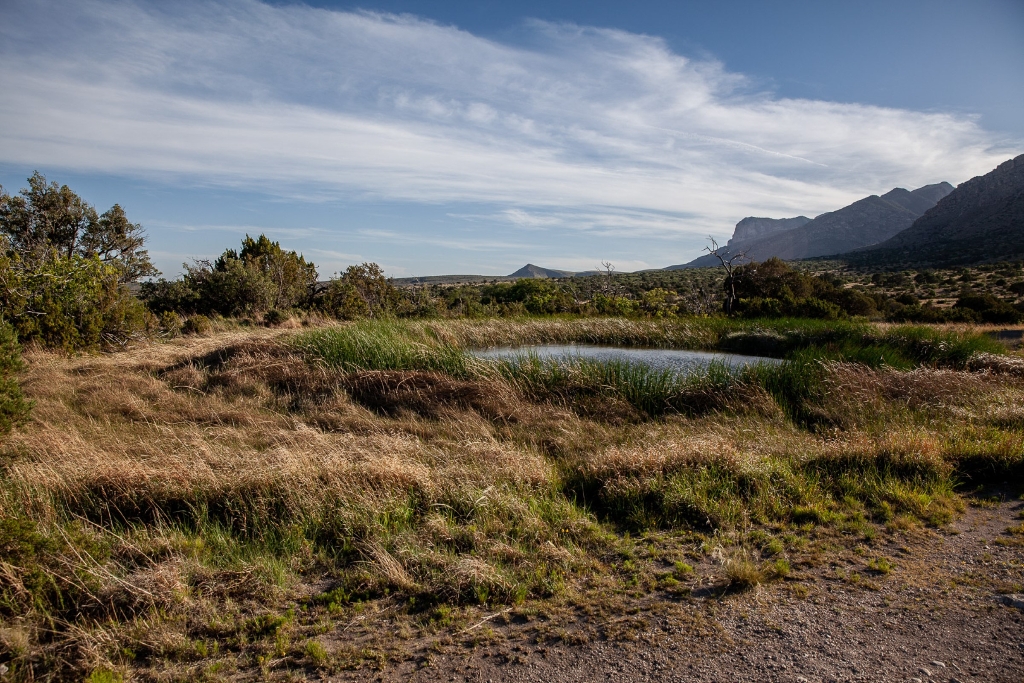
Manzanita Spring did not always look as it does today. The Smith Family periodically dredged the spring and used it to help irrigate crops. Before the arrival of the Smiths, a bog surrounded the spring. Maps from the 1870s and 1880s call it Cienaga (Bog), Tule (Rush), and Escondido (Hidden) Spring.
Manzanita Spring is a good place to observe some of the region's unique wildlife. Watch for mule deer, elk, javelina, gray fox, and birds like violet-green swallows and white-throated swifts.
As you continue along the Smith Spring Trail, notice how the desert plants are well adapted for survival in an arid land. The leaves of agaves and yuccas form a circular pattern allowing rainwater to flow down the grooves in the leaves straight to the heart and root system of the plant.
Other plants like the gray oak have very small leaves that don't collect as much sunlight as larger leaves would. This helps prevent the tree from losing too much moisture. Some desert plants don't have any leaves, while others will drop their leaves during dry periods to conserve water.
Cacti can store water collected during rain events to rely on later during periods of drought. These plants are also eaten by animals like javelina or deer, which rely on the moisture contained in cactus pads to survive in the arid desert environment.
As you are walking along the trail, look at the mountains ahead of you. Although dry today, water is the creator of this landscape. An ancient sea sustained the creatures which would create the reef that we now know as the Guadalupe Mountains. Algaes and sponges living in an ancient sea that covered this area over 250 million years ago helped form what is now one of the best examples of an exposed fossil reef anywhere in the world.
Manzanita Spring is a good place to observe some of the region's unique wildlife. Watch for mule deer, elk, javelina, gray fox, and birds like violet-green swallows and white-throated swifts.
As you continue along the Smith Spring Trail, notice how the desert plants are well adapted for survival in an arid land. The leaves of agaves and yuccas form a circular pattern allowing rainwater to flow down the grooves in the leaves straight to the heart and root system of the plant.
Other plants like the gray oak have very small leaves that don't collect as much sunlight as larger leaves would. This helps prevent the tree from losing too much moisture. Some desert plants don't have any leaves, while others will drop their leaves during dry periods to conserve water.
Cacti can store water collected during rain events to rely on later during periods of drought. These plants are also eaten by animals like javelina or deer, which rely on the moisture contained in cactus pads to survive in the arid desert environment.
As you are walking along the trail, look at the mountains ahead of you. Although dry today, water is the creator of this landscape. An ancient sea sustained the creatures which would create the reef that we now know as the Guadalupe Mountains. Algaes and sponges living in an ancient sea that covered this area over 250 million years ago helped form what is now one of the best examples of an exposed fossil reef anywhere in the world.
Is there something we missed for this itinerary?
Itineraries across USA

Acadia

Arches National Park

Badlands

Big Bend

Biscayne

Black Canyon Of The Gunnison

Bryce Canyon

Canyonlands

Capitol Reef

Carlsbad Caverns

Channel Islands

Congaree

Crater Lake

Cuyahoga Valley

Death Valley

Dry Tortugas

Everglades

Gateway Arch

Glacier

Grand Canyon

Grand Teton

Great Basin

Great Smoky Mountains

Guadalupe Mountains

Haleakalā

Hawaiʻi Volcanoes

Hot Springs

Indiana Dunes

Isle Royale

Joshua Tree

Kenai Fjords

Kobuk Valley

Lassen Volcanic

Mammoth Cave

Mesa Verde

Mount Rainier

North Cascades

Olympic

Petrified Forest

Pinnacles

Rocky Mountain

Saguaro

Shenandoah

Theodore Roosevelt

Virgin Islands

Voyageurs

White Sands

Wind Cave

Yellowstone

Yosemite

Zion